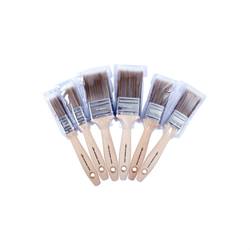If you walk into any store that sell paint, like Crown Showroom or Hardwares chances are that when you go to look for a brush you are going to be overwhelmed. Once you are overwhelmed with choices, odds are you will probably just go with some basic brush for “just cause”. You’ll then head home, start your project and end up cursing your brush as it frays, clumps and generally tries to sabotage your painting project.
Paint brush widths that you will most commonly find are 1″ – 3″ with some specialty brushes being up to 5 inches. Typically smaller width brushes are great for delicate work and small hard to reach areas while the wider 2-3 inch brushes are great for cutting in ceiling and trim as you won’t have to dip these brushes back into your paint. With over 35 years of brush making experience, Crown is recognized in the beauty industry as a global leader in cosmetic brushes. Always evolving with an everchanging market, Crown continuously manufactures quality products beloved by the professional beauty industry, including their new cosmetic line available now.
Crown Brushes Uk
Understanding paint brushes is a big part of making sure you have the right tools for the right painting project. It also helps you understand what you are paying for when you purchase a more expensive paint brush and why this more expensive paint brush will likely save you lots of time and even money.
The Parts Of A Paint Brush
Before we can talk too much about paint brushes you need to understand what all the different pieces of the brush are what they are called (there is more to a brush than bristles and a handle!)
Handle – While it may seem incredibly basic, the handle is the part of the brush that you hold onto and makes a huge difference in the feel of the brush, especially if you are using it for hours at a time. Handles are typically made out of plastic or wood with wood typically being the material of choice for higher quality brushes.

Ferrule – The ferrule is the metal strip in between the handle and the bristles that holds the two together. A quality ferrule should hold the bristles in without any coming off while painting.
Bristles – The bristles are the part of the brush that hold the paint and release it on your painting surface. The bristles can be made out of many different types of material with each being better suited for different applications. The bristles are also cut different depending on quality and intended use.

All About Bristles
Bristles are really what creates the differences between brushes. You may see different handles and ferrules, but in the end, it’s the bristles that are the truly important part of any paint brush.
Bristle Cuts:
Crown Brushes Makeup
Flat Cut: Flat cut brushes are where all the bristles are cut to the same length. If you hold the handle of your brush straight up and down all the bristles will be the same length (except for a small variation at the tip if it is tapered, see below). These brushes are great general purpose brushes and are ideal for painting larger surfaces such as doors, windows and trim.
Sash (angle) Cut: A sash cut brush is when the bristles form an angle going up. If you hold your brush handle straight up you will see a variation (usually about inch worth) between the ends of the bristles. Sash brushes tend to give you more control over your brush lines. Sash brushes are great for cutting in ceiling and anywhere else you need sharp lines.

Tapered Ends: A taper on a brush means that when looking straight across the ends of the bristles of the brush, they will form a slight tip (usually right in the middle of the brush). Note: this is not referring to a sash or angle brush but more a slight tip forming across the entire brush. A higher quality brush will have a tapered end where a cheaper brush will have a flat cut (like a buzz cut). A tapered end will help the paint flow off the brush better and help you to cut sharper lines.
Bristle Width: The bristle width is another important thing to consider when choosing the right paint brush. Paint brush widths that you will most commonly find are 1″ – 3″ with some specialty brushes being up to 5 inches. Typically smaller width brushes are great for delicate work and small hard to reach areas while the wider 2-3 inch brushes are great for cutting in ceiling and trim as you won’t have to dip these brushes back into your paint as often.
Width also refers to the fatness of the brush. Some paint brushes are thin while others are thick. A thicker brush is better if you plan on painting large surfaces with the brush while thinner brushes are better for simply cutting in and around things.
Crown Hair Brushes
Next time you step into the hardware, you will know how to pick your brush. Happy Painting!
